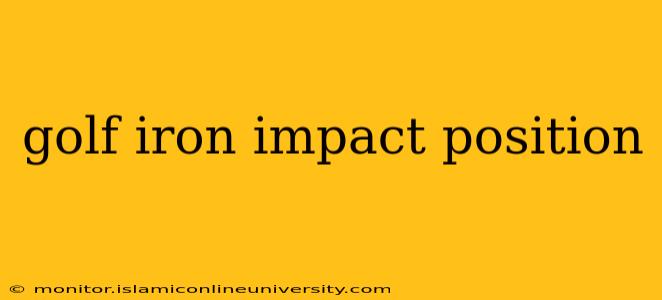Achieving a consistent and powerful golf swing hinges on many factors, but few are as crucial as your impact position. Understanding and mastering your impact position with irons is the key to unlocking lower scores and a more enjoyable game. This comprehensive guide will delve into the intricacies of proper impact position, addressing common questions and offering actionable advice.
What is the Ideal Golf Iron Impact Position?
The ideal golf iron impact position is a dynamic state, not a static image. However, several key elements consistently contribute to a successful impact:
-
Weight Distribution: Your weight should be centered, slightly favoring your lead side (left side for right-handed golfers). A significant shift of weight to the rear foot indicates a late weight transfer, often leading to thin shots. Conversely, too much weight on the front foot can lead to fat shots. The balance is crucial.
-
Posture: Maintain a relatively upright posture throughout your swing, resisting the urge to hunch or sway excessively. A slight bend at the knees allows for a natural turn and efficient weight transfer. Maintaining your posture helps maintain club path and consistency.
-
Wrist Hinge: Your wrists should be appropriately hinged at impact, allowing for proper clubhead speed and efficient energy transfer into the ball. Excessive wrist hinge can lead to an over-the-top swing, while insufficient hinge often results in a weak, pushed shot.
-
Clubface Squareness: The clubface should be square (or slightly closed) to your target line at impact. A closed clubface will typically produce a draw, while an open clubface will cause a slice. Squaring the clubface at impact is a crucial element of accuracy.
-
Body Position: Your shoulders should be relatively level, with the hips slightly rotated toward the target. Avoid excessive rotation, which can lead to a loss of power and accuracy.
What are the common mistakes in golf iron impact position?
Many golfers struggle with achieving the ideal impact position. Here are some common mistakes:
- Casting: This involves releasing the club too early, often resulting in a weak, topped shot. Casting usually originates from a poor wrist hinge.
- Scooping: This is the opposite of casting, where the golfer tries to lift the ball into the air, resulting in fat shots.
- Swaying: Excessive swaying during the downswing disrupts weight transfer and leads to inconsistent contact.
- Early Extension: This is when the golfer stands up too early in the downswing, typically before impact, resulting in thin shots.
How can I improve my golf iron impact position?
Improving your impact position requires practice and drills. Here are some helpful techniques:
- Impact Bag Drills: Practicing with an impact bag helps develop the feeling of solid contact.
- Video Analysis: Recording your swing and analyzing it helps identify areas for improvement.
- Professional Lessons: A qualified golf instructor can provide personalized feedback and guidance.
- Consistent Practice: Regular practice is essential for developing muscle memory and improving your swing.
How do I know if my weight is properly distributed at impact?
You should feel balanced and centered at impact, not leaning heavily on either foot. A helpful drill is to practice your swing with your eyes closed. If you lose your balance easily, your weight distribution needs improvement.
How does my grip affect my impact position?
Your grip significantly influences your impact position. A weak grip promotes an out-to-in swing path, and a strong grip encourages an in-to-out swing path, both leading to inconsistent shots. Maintaining a neutral grip allows for a square clubface at impact.
What is the best way to practice my impact position?
Focus on drills that promote proper weight transfer, wrist hinge, and posture. Slow-motion practice swings, impact bag drills, and video analysis are all effective methods. Remember consistency and patience are key.
By meticulously focusing on your impact position, consistently working on drills, and seeking professional guidance when needed, you will significantly improve your golf game. Consistent strikes will follow, leading to lower scores and a greater enjoyment of the sport. Remember, the journey to perfecting your impact position is a continuous process; celebrate small wins along the way.
